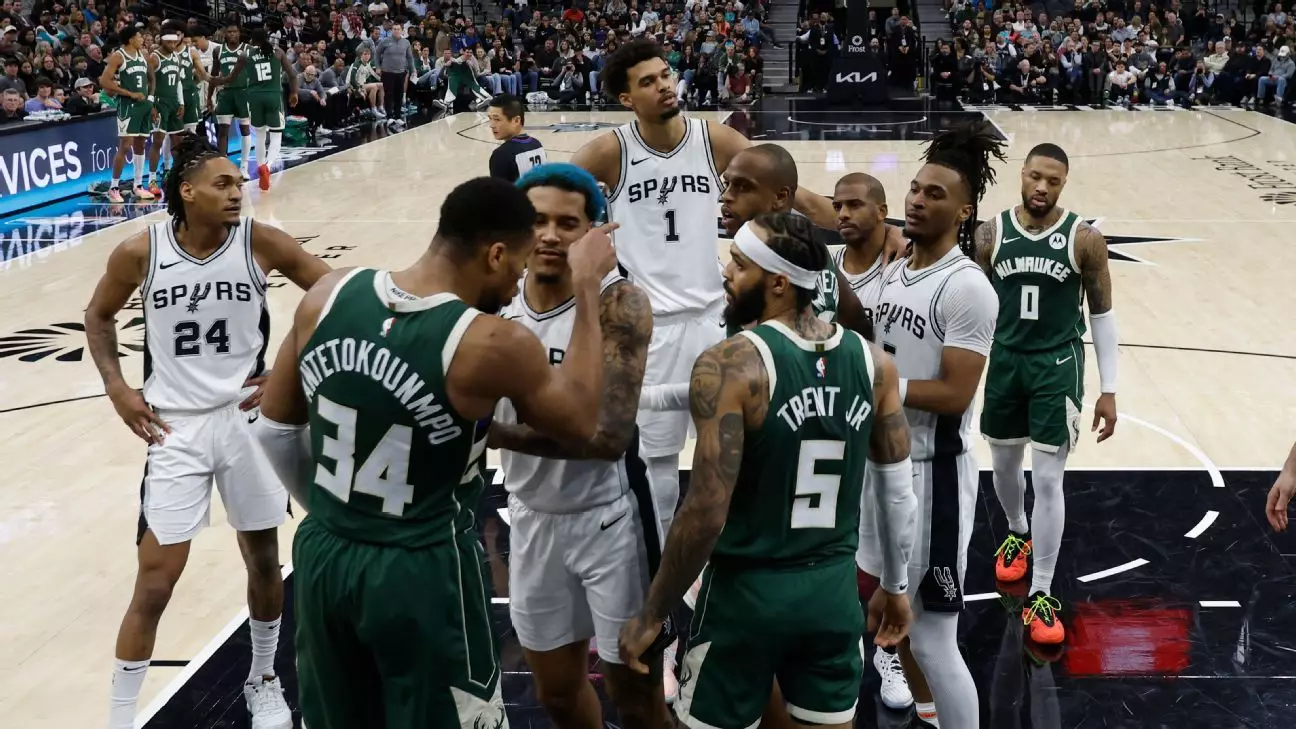The Milwaukee Bucks faced off against the San Antonio Spurs in a match that highlighted the intensity and passion of professional basketball yet was marred by a controversial foul that triggered frustration from star player Giannis Antetokounmpo. As both teams battled it out on Friday night, the game revealed not just the physical nature of the sport but also the underlying emotions and stakes involved for its participants.
During the fourth quarter of the game, with 3:46 left on the clock and the Bucks lagging behind at 131-111, the atmosphere on the court shifted dramatically. Antetokounmpo received a well-timed bounce pass from teammate Taurean Prince, which set up an explosive opportunity. As he spun towards the basket, he encountered a trio of defenders: Chris Paul, Jeremy Sochan, and Devin Vassell. While attempting to maneuver between Sochan and Paul, Antetokounmpo felt the full force of a foul that sent him crashing to the floor, hitting his right hip and back hard.
This instance was not just a standard foul; it was a moment that encapsulated the high stakes of competitive basketball. The incident drew immediate attention, not just for the physicality but also for the subsequent reaction from both players involved. Antetokounmpo, known for his typically calm demeanor, exhibited visible frustration, prompting him to seek a conversation with Paul post-game.
Antetokounmpo’s Response: A Tipping Point?
After being helped up by teammate Gary Trent Jr., Antetokounmpo’s confrontation with Paul didn’t dissipate even after the final buzzer. In a moment of tension, he lingered on the court, waiting to exchange words with Paul. This is significant given Antetokounmpo’s reputation for his composed attitude and sportsmanship. The exchange escalated into an indicator of deeper emotions tied to the game and respect among players.
When questioned about the incident, Antetokounmpo’s initial response downplayed the severity of the foul, labeling it as merely “a physical play.” However, he later elaborated that there are thresholds in player interactions that shouldn’t be crossed. He articulated that respect is innate among athletes, but when boundaries are pushed, it can lead to serious consequences—very much indicating that while he may come off as mild-mannered, there exists a limit to his patience.
Reflecting on what transpired, Antetokounmpo emphasized the importance of mutual respect and the implications of actions on fellow players’ careers. His profound observation about the duality of sport—where competitive aggression can foster both laughter and tears—highlights one of the most prominent challenges in high-stakes environments like the NBA. The emotional aspects of the game extend well beyond the physical, often intertwining with personal livelihoods and aspirations.
Coach Doc Rivers, acknowledging the player’s character, remarked on Antetokounmpo’s typically levelheaded nature. Such comments underscore the gravity of the incident—if a composed player like Antetokounmpo reacts fiercely, it signifies that all players must recognize the serious ramifications of their actions on the court.
This particular incident overshadowed what was otherwise an engaging contest between some of the league’s most esteemed talents. Antetokounmpo delivered a standout performance, amassing 35 points, 14 rebounds, and six assists, marking his achievement of tying the franchise record set by Kareem Abdul-Jabbar for consecutive games scoring 35 or more points along with 10 rebounds. Meanwhile, Spurs rookie Victor Wembanyama showcased his prowess with an impressive blend of offensive and defensive skills.
Collectively, these players represent the promising future of the league. Yet, the incident serves as a reminder of the fine line athletes walk in the pursuit of excellence. Whether through a standout performance or a moment of altercation, the emotional dynamics within basketball continue to shape the narratives enclosing its games, highlighting both the brilliance and volatility of professional sports.

